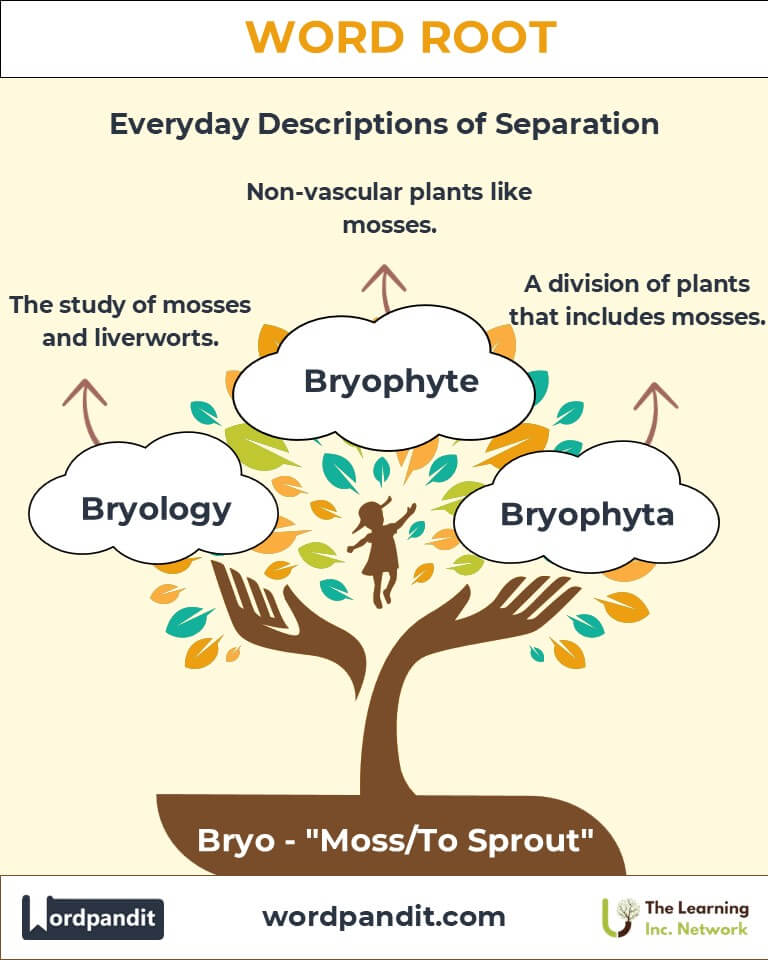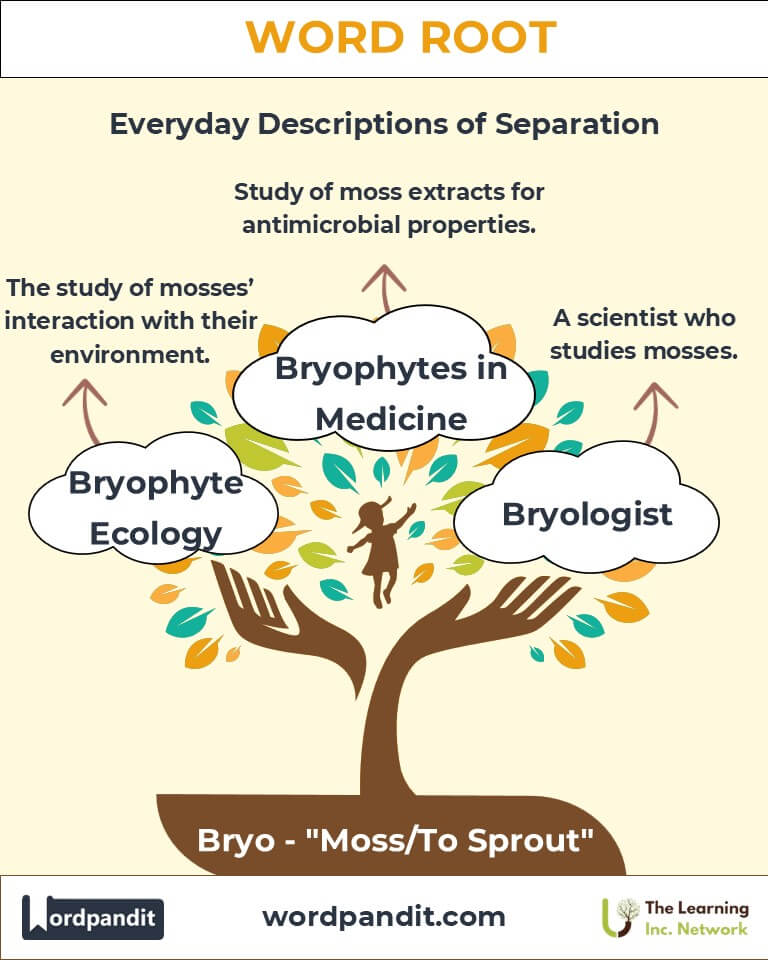Bryo: The Root of Growth and Moss in Language and Science
Byline:
Delve into the intriguing world of the word root "Bryo," derived from the Greek word meaning "moss" or "to sprout." From biology to botany, this root forms the foundation of terms that describe growth, resilience, and the beauty of the natural world.

Table of Contents
- Introduction: The Essence of "Bryo"
- Etymology and Historical Journey
- Mnemonic: Unlocking the Power of "Bryo"
- Common "Bryo"-Related Terms
- "Bryo" Through Time
- "Bryo" in Specialized Fields
- Illustrative Story: "Bryo" in Action
- Cultural Significance of "Bryo"
- The "Bryo" Family Tree
- FAQs about the "Bryo" Word Root
- Test Your Knowledge: "Bryo" Mastery Quiz
- Conclusion: The Living Legacy of "Bryo"
Introduction: The Essence of "Bryo"
Imagine a lush forest floor blanketed with soft green moss, a symbol of growth, renewal, and persistence. The word root "Bryo" (pronounced BRY-oh) stems from the Greek word "bryon," meaning "moss" or "to sprout." This root underpins terms in botany, ecology, and beyond, capturing the transformative power of nature and its ceaseless ability to regenerate.

Etymology and Historical Journey
The root "Bryo" originates from the ancient Greek "bryon," a word used to describe moss-like plants and sprouting vegetation. In classical times, moss was considered a representation of modesty and quiet growth. Over centuries, the root "Bryo" evolved into scientific terminology, finding its place in botany and biology to describe processes of sprouting and species like bryophytes—a group of non-vascular plants.
Mnemonic: Unlocking the Power of "Bryo"
To remember "Bryo," visualize a bed of moss slowly sprouting on a rock, symbolizing resilience and growth even in harsh conditions.
Mnemonic Device:
"Bryo brings life to barren stones, sprouting greenery where none was known."
Common "Bryo"-Related Terms
- Bryophyte (BRY-oh-fite): Non-vascular plants like mosses.
Example: "Bryophytes thrive in damp environments, covering rocks and soil with their lush greenery." - Bryology (BRY-oh-loh-jee): The study of mosses and liverworts.
Example: "The botanist specialized in bryology, exploring mosses’ role in forest ecosystems." - Bryophyta (BRY-oh-fy-tuh): A division of plants including mosses.
Example: "Bryophyta encompasses diverse species that contribute to ecological balance." - Bryologist (BRY-oh-loh-jist): A scientist who studies mosses.
Example: "The bryologist discovered a new moss species in the rainforest." - Bryophyte Ecology (BRY-oh-fite ee-KOL-uh-jee): The study of mosses’ interaction with their environment.
Example: "Bryophyte ecology highlights mosses’ role in preventing soil erosion."
"Bryo" Through Time
- Ancient Uses: Moss was seen as a humble yet persistent plant, often used in herbal remedies.
- Modern Science: The root "Bryo" became integral to botanical studies, particularly with the classification of bryophytes in the 18th century.
"Bryo" in Specialized Fields
- Botany: Bryophytes include mosses, liverworts, and hornworts, critical for understanding plant evolution.
- Ecology: Bryophyte ecology examines mosses’ role in habitats, including water retention and nutrient cycling.
- Pharmaceuticals: Extracts from bryophytes are studied for antimicrobial and anti-inflammatory properties.
- Environmental Science: Mosses are bioindicators, reflecting the health of ecosystems by absorbing pollutants.
Illustrative Story: "Bryo" in Action
Deep in a misty forest, young ecologist Mira was tasked with restoring an eroded hillside. She introduced native bryophytes to the barren soil, knowing their ability to retain water and stabilize the ground. Over months, the mosses flourished, creating a vibrant green carpet that transformed the landscape. Mira’s success highlighted how the humble bryophyte could heal the earth and inspire sustainable practices.
Cultural Significance of "Bryo"
In many cultures, moss symbolizes resilience and renewal. Japanese gardens often feature moss for its aesthetic and symbolic value, representing harmony and the passage of time. Folklore in some regions associates moss with nurturing spirits of the forest, underscoring its cultural and spiritual importance.

The "Bryo" Family Tree
- Phyto- (Plant): Examples: Phytoplankton, Phytochemistry.
- Botan- (Plant, Herb): Examples: Botanical, Botanist.
- Eco- (Environment): Examples: Ecology, Ecosystem.

FAQs About the Bryo Root
Q: What does "Bryo" mean?
A: The root "Bryo" comes from the Greek word "bryon," which means "moss" or "to sprout." It reflects growth and regeneration, especially in nature, where mosses thrive in challenging environments.
Q: What are bryophytes?
A: Bryophytes are a group of non-vascular plants, including mosses, liverworts, and hornworts. Unlike most plants, they lack vascular tissues like xylem and phloem, relying on their moist surroundings for water and nutrient absorption.
Q: Who studies mosses?
A: Bryologists are scientists who specialize in the study of mosses and similar plants. Their work is essential for understanding the role of bryophytes in ecosystems, such as their ability to retain water and prevent soil erosion.
Q: What is bryology?
A: Bryology is the branch of botany focused on the scientific study of mosses, liverworts, and hornworts. This field explores their biology, classification, and ecological importance.
Q: Why are bryophytes important?
A: Bryophytes play vital roles in ecosystems by stabilizing soil, retaining water, and acting as indicators of environmental health. They also provide habitats for small organisms.
Q: Can bryophytes survive in harsh conditions?
A: Yes, bryophytes are incredibly resilient. They thrive in diverse environments, from arctic tundras to tropical forests, often colonizing areas unsuitable for other plants.
Q: Are mosses used in medicine?
A: Certain bryophytes have antimicrobial and anti-inflammatory properties. Their extracts are studied for potential applications in pharmaceuticals, particularly in combating bacterial infections.
Test Your Knowledge: Bryo Mastery Quiz
1. What does the root "Bryo" mean?
2. Which term refers to the study of mosses?
3. What are bryophytes?
4. What role do bryophytes play in ecosystems?
5. Who is a bryologist?
Conclusion: The Living Legacy of "Bryo"
The root "Bryo" encapsulates growth, renewal, and the quiet strength of nature. From ancient observations of moss to modern scientific advancements, "Bryo" symbolizes resilience and the interconnectedness of life. As we continue to study and appreciate the natural world, the legacy of "Bryo" reminds us of the power of small, persistent things to transform landscapes and lives alike.












